The practice of self-insuring for health benefits claims has been on a steady upward climb over the past two decades. The Affordable Care Act (ACA) was predicted to trigger a spike in self-insurance — particularly among smaller employers. But, at least so far, the reality is different.
The basis of the prediction was an anticipated upward cost pressure on fully insured plans attributable to, among other factors, new ACA-imposed taxes on insurance companies. "To the degree small employers are concerned about the rising cost of providing health coverage, self-insurance may become a more attractive means to mitigate any expected regulatory cost increases," suggests Self-Insured Health Plans: State Variation and Recent Trends by Firm Size, 1996-2013, a 2015 study by the Employee Benefit Research Institute (EBRI).
Regardless of the ACA's impact, fully insured employers may find savings opportunities by switching to self-insurance. It's a move that requires careful analysis, however.
Role of employer size
Under the self-employed model, an employer funds and operates its own health plan as opposed to buying a fully insured plan from an insurance carrier and paying premiums to that insurer. Self-insuring allows a company to save money on the profit margin built into insurer premiums, but the employer assumes more financial risk should it incur more claims than expected.
According to the EBRI study, as of 2013 (the most recently available data), 38% of private sector employers were self-insured. But the prevalence of self-insuring varied widely by employer size: 65% of employers with at least 50 employees were self-insured that year, vs. only 13% of the under-50 employee group. EBRI's data also shows that the proportion of self-insured smaller employers has remained essentially constant since 1996.
Another slice of the EBRI data — employers with 100 to 499 employees — shows a downward trend in self-insurance, from 35% in 1996 to 25% in 2013. No explanation is suggested for this trend.
Significant variations also are apparent by industry sector and geography. For example, 56% of retailers self-insured, but only 28% of manufacturers. In Nebraska and Indiana, 74% and 71% self-insured, respectively, vs. 47% in New York and Rhode Island.
The low prevalence of self-insuring among smaller employers might be explained by several factors, including:
- Lack of internal resources required to conduct the required analysis,
- Insufficient self-insurance expertise on the part of health insurance brokers who handle small plans, and
- Risk-aversion-based unwillingness to assume greater exposure to unusually high claims experience.
It's also possible that, in some scenarios, the economics simply don't add up.
Stop-loss coverage
A critical variable in the financial viability of self-insuring is the cost of stop-loss insurance. That coverage, as its name suggests, caps employer liability for health claims. It's the insurance industry's equivalent of a high-deductible plan for employers; the higher the stop-loss threshold (also known as the "attachment point"), the cheaper the coverage. Other variables also come into play, including your plan design, claims experience, workforce demographics and health care provider networks.
Stop-loss coverage is typically purchased with a cap on employer liability for each individual claim. Some employers also purchase an aggregate cap on all employee claims, over the duration of the contract period.
One common characteristic of stop-loss coverage is that premiums tend to rise each year at a faster pace than underlying medical costs. This is usually because of what's known as the "leverage effect" — that is, as medical costs rise, a higher proportion of claims exceed deductible amounts. The effect is a larger jump in dollar outlays than the medical cost inflation rate.
Average premiums
The International Society of Certified Employee Benefit Specialists (ISCEBS) surveys its members annually on stop-loss trends. The most recent survey, conducted in 2015, projected an average premium rate increase of 12%.
The survey also revealed that only 16% of employers that had decided whether to adjust their coverage terms chose to raise their stop-loss threshold to moderate or avoid significant premium increases. The remaining 84% decided to keep their current stop-loss thresholds — even at the expense of a jump in premiums.
Although, as noted, stop-loss premiums vary widely based on several criteria, the ISCEBS survey did calculate averages based on the individual stop-loss amounts and contract types. A common contract type is a "12/15" policy, which covers claims incurred during a 12-month period, but paid as long as three months after the contract period ends (that is, 15 months after the beginning of the contract term). That three-month cushion reflects the practical reality that claims incurred late in the contract year might take as long as three months to process.
Average monthly premiums, according to the ISCEBS survey, varied from $93.43 for policies with a stop-loss threshold of $100,000 for each individual claim, to $15.22 for policies with a stop-loss threshold of $500,000 for each individual claim. Average premiums were similar for the reverse of a 12/15 contract, a 15/12 one. Under this arrangement, the policy covers claims incurred up to three months before the beginning of the contract year, but paid within the 12-month contract period.
Objective support
Whether self-insuring makes sense for any employer depends on multiple factors. If you're considering the possibility, be sure to get support for the financial analysis from a party that doesn't have a stake in the outcome of the decision.
LEARN MORE: Find out how one self-funded entity cut $800,000 in health costs.
Do you have questions about self-insurance?
Contact: Ron Present, Partner and Health Care Industry Group Leader, at 314.983.1358 or rpresent@bswllc.com
Bill Goddard, Principal, Insurance Advisory Services, at 314.983.1253 or bgoddard@bswllc.com
The content of this article is intended to provide a general guide to the subject matter. Specialist advice should be sought about your specific circumstances.



